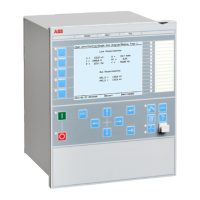The function is divided into two parts. The SOTF function will give operation from
step 2 or 3 during a set time after change in the position of the circuit breaker. The
SOTF function has a set time delay. The under time function, which has 2
nd
harmonic restrain blocking, will give operation from step 4. The 2nd harmonic
restrain will prevent unwanted function in case of transformer inrush current. The
under time function has a set time delay.
Below the settings for switch on to fault logics are described.
SOTF: This parameter can be set: Off/SOTF/Under Time/SOTF+Under Time.
ActivationSOTF: This setting will select the signal to activate SOTF function; CB
position open/CB position closed/CB close command.
StepForSOTF: If this parameter is set on step 3, the step 3 start signal will be used
as current set level. If set on step 2, the step 2 start signal will be used as current set
level.
HarmBlkSOTF: This is used to On/Off harmonic restrain during SOTF conditions.
tSOTF: Time delay for operation of the SOTF function. The setting range is 0.000 -
60.000 s in step of 0.001 s. The default setting is 0.100 s
t4U: Time interval when the SOTF function is active after breaker closing. The
setting range is 0.000 - 60.000 s in step of 0.001 s. The default setting is 1.000 s.
ActUnderTime: Describes the mode to activate the sensitive undertime function.
The function can be activated by Circuit breaker position (change) or Circuit
breaker command.
tUnderTime: Time delay for operation of the sensitive undertime function. The
setting range is 0.000 - 60.000 s in step of 0.001 s. The default setting is 0.300 s
7.2.3.5 Settings for each step (x = 1, 2, 3 and 4)
M15282-9 v12
Operation: Sets the protection to On or Off.
DirModex: The directional mode of step x. Possible settings are Off/Non-
directional/Forward/Reverse.
Characteristx: Selection of time characteristic for step x. Definite time delay and
different types of inverse time characteristics are available.
Inverse time characteristic enables fast fault clearance of high current faults at the
same time as selectivity to other inverse time phase overcurrent protections can be
assured. This is mainly used in radial fed networks but can also be used in meshed
networks. In meshed networks, the settings must be based on network fault
calculations.
To assure selectivity between different protections, in the radial network, there has
to be a minimum time difference Dt between the time delays of two protections. To
Section 7 1MRK 505 388-UEN B
Current protection
108 Busbar protection REB650 2.2 IEC
Application manual

